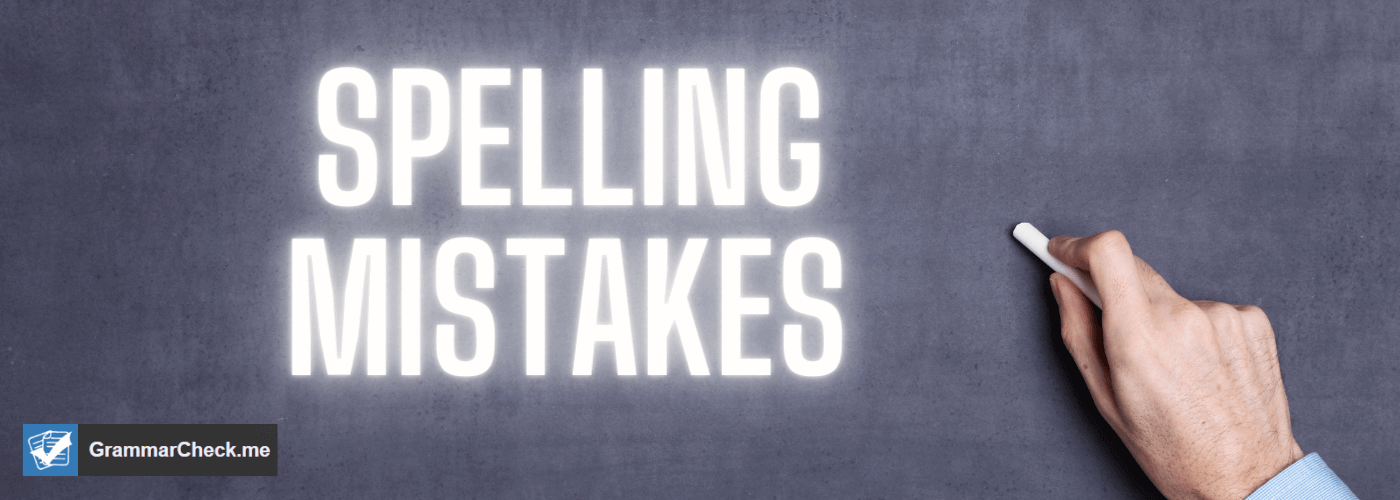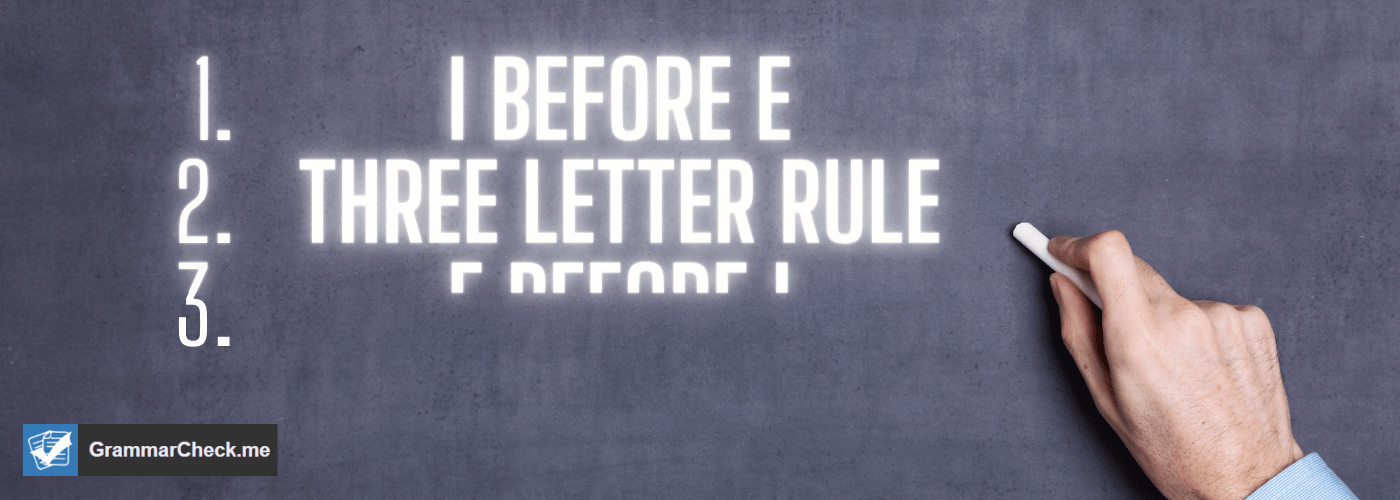There are many English spelling rules that can seem confusing to spellers. This article will outline the most common English spelling rules and provide examples of how to apply them. After reading this post, you’ll be able to spell words correctly and catch your mistakes while proofreading every time.
Always using the right words? Make sure:
Check Your TextMost Common Spelling Rule

The most basic spelling rule you need to know is the distinction between consonants and vowels. These rules apply to all writing. It doesn’t matter if you are writing a formal memo or a fictional story.
- Vowels include a, e, i, o, u, and sometimes y and w.
Consonants are all the remaining letters that are not vowels. If you hear a one-syllable word with a soft vowel, the vowel is usually in the middle. It is very easy to mix up vowels like in Messege or Message.
On the other hand, if a word is comprised of the vowel-consonant-e structure, the final e is usually mute; in other words, the -e will not be pronounced even though it exists in spelling. However, most spelling mistakes like unorganized and disorganized are just silly mistakes.
Takeaway: You should understand the difference between vowels and consonants.
Tenses
Some of the most simple English spelling rules involve a basic understanding of tenses. You must have an understanding of verb tenses to master almost all British & American grammar rules.
- First, you should add the suffix -ed to all verbs in past tense.
For example, “walk” becomes “walked” when you are describing the act which occurred in the past. For verbs used in present-continuous tense, add -ing. Here is an example: I am reading right now. Notice that “read” becomes “reading” under this circumstance.
Takeaway: You should add the suffix -ed to all verbs in past tense.
Plural Nouns
Other English spelling rules have to do the plural form of nouns. These are the plural versions of singular nouns like aunty or auntie.
- For most nouns, you can simply add -s after the word. For example, you spell “cats” if there are more than one of them.
However, nouns that end with -ch, -s, -es, -x, and -z require more attention. When a word ends like this, you will need to add -es to signify a plural form.
Here are some examples:
- “watch” becomes “watches”
- “tax” becomes “taxes”
- “pass” becomes “passes”
This rule in fact applies not only to plural noun forms, but also to singular verbs used under present tense.
Another special case is words that end with -y. For these words, you should replace the -y with -ies if you want to make them into a plural form. For example, there are more than one “babies,” not more than one “babys.” Pay close attention to the spelling of singular and plural words!
Takeaway: Add an -s after a noun to make it plural.
Other Rules

There are other simple spelling rules that will allow you to spell correctly without knowing much about tenses and usage.
Add a suffix to words that end with -e
First, if you want to add a suffix to words ending with -e, you will need to drop the -e. Here are some examples: the noun form of “guide” is spelled “guidance,” while the present-continuous tense of “hope” is “hoping.”
Change the final -y in a word into -i
Another easy spelling rule is changing the final -y in a word into -i before you add a suffix to the word. For example, the noun form of “defy” is “defiance.” However, remember that there are certain exceptions to this rule, such as “journeying” and “memorize.”
“The Three-Letter Rule”
Have you ever wondered why most content words have at least three letters? Well, there’s a rule for that – it’s called the Three-Letter Rule.
The Three-Letter Rule is a general guideline for writers, bloggers, journalists, academics, and editors. It states that most content words should have three letters. This rule helps to ensure that texts are easy to read and understand.
However, there are exceptions to the rule. Some short words, such as “I” and “a”, are essential for sentence construction. However, in general, most content words should follow the Three-Letter Rule.
E before I
One of the most common spelling mistakes is knowing when to use “e before i.” This rule applies when the sound of the letter is long a, as in the word “beach.” So if you’re ever unsure about how to spell a word, just remember: if the sound is long a, write e before i.
Capitalize Proper Nouns
English words that are proper nouns should always be capitalized.
In the English language, proper nouns refer to a specific person, place, or thing.
As a result, they are always capitalized. For example, the word “Queen” would be capitalized because it is specific to one particular person. Similarly, the word “Paris” would be capitalized because it refers to a specific city.
Doubling a Final Consonant
A word with one syllable usually doubles its final consonant when adding a suffix that begins with a vowel (-ed, -ing).
For example, the word “hop” becomes “hopped” and ” hopping.” You would not double the final consonant of a word like “running” because are not one-syllable words.
I Before E, Except After C
The spelling rule “I Before E, Except After C” is a handy tool to help with common spelling mistakes.
However, there are some exceptions to the rule, such as “seize” and “science.”
In addition, there are some words that follow the rule but don’t follow this spelling pattern differently, such as “weird” and “height.” Nevertheless, the rule is a good place to start when faced with a spelling challenge. And who knows, maybe one day there will be an exception to the exception!
Sometimes, like in the words greatful and grateful, people just make silly mistakes. They just need some practice to master basic spelling rules!
History Of The English Language
The English language is one of the most popular languages in the world. In fact, there is more than 1.2 billion English speakers worldwide.
The English language is closely related to German and Dutch languages. It has a rich history, dating back to the historic Germanic tribes who first settled in Britain.
Over the centuries, English has been influenced by many other languages.
- Latin
- French
- Arabic
As a result, it has become one of the most flexible and adaptable languages in existence. Sure there are fancy rules about how to use a short vowel or double consonant that can make this language tricky for some people. Word choice is a very important part of the English language. Remember that overly intricate text is never a good thing!
However, English is a growing language used around the world for business, technology, and diplomacy. It is also one of the most popular second languages, spoken by people all over the world.
Most Common English Spelling Rules With Examples!
- The silent “e” rule: When adding a suffix to a word that ends with a silent “e,” the “e” is dropped. For example, “move” becomes “moving” and “like” becomes “liking.”
- The “i before e” rule: In most cases, “i” comes before “e” except after “c” or when sounding like “ay” as in “neighbor” or “weigh.”
- The double consonant rule: When adding a suffix to a word that ends in a consonant, preceded by a single vowel, the consonant is doubled. For example, “run” becomes “running” and “big” becomes “bigger.”
- The “y” to “i” rule: When adding a suffix that begins with a vowel to a word that ends in “y,” the “y” is changed to “i.” For example, “baby” becomes “babies” and “happy” becomes “happiness.”
- The “tion” and “sion” rule: Words that end in “t” or “te” may add “-ion” to form “tion” or “sion,” respectively. For example, “operate” becomes “operation” and “compete” becomes “competition.”
Frequently Asked Questions
When a word has two syllables and the second syllable is stressed, you double the consonant before adding “-ed” or “-ing”. For example, “admit” becomes “admitted” and “refer” becomes “referred”. When a word has more than one syllable and the penultimate (next to last) syllable is stressed, you don’t double the consonant before adding “-ed” or “-ing”. For example, “occasion” becomes “occasional” and ” sufficient” becomes “sufficiently”.
While there are a few common rules that English spelling follows, there are unfortunately no hard and fast rules that apply 100% of the time. There are probably 5-8 most common spelling rules. English is a complicated language, and even native speakers sometimes have trouble with spelling!
1) I before E except after C
2) The Silent “e”
3) U follows Q
4) Double Consonants
5) Adding -ed to a word ending in -y changes the y to an i and adds -ed
6) When two vowels go walking, the first one does the talking
“Receipt” is the proper spelling. The word “receipt” is derived from the Latin word “recipere” which means “to take.” In other words, when you receive something, you are taking it in.
The word “restaurant” is spelled r-e-s-t-a-u-r-a-n-t. It is derived from the French word “restaurer” meaning “to restore.” A restaurant is a business that serves food and drinks to customers.
Beautiful is spelled B-E-A-U-T-I-F-U-L. The word beauty comes from the Latin beata, meaning “blissful, happy.” In English, beauty refers to something that pleases the senses, such as a pleasing appearance or a pleasant smell.
Final Thoughts
Spelling doesn’t have to be hard. With a little practice, and by following these simple rules, you can spell words correctly almost every time. And if you can’t memorize all the spelling rules then use our FREE Spell Checker! Remember, misspelled words can distract your readers and affect your writing. Use these tips to improve your writing and make sure your spelling is perfect!
